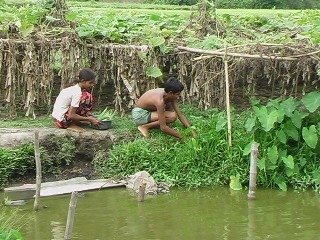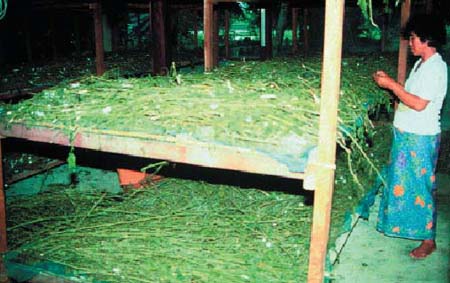|
Horticulture-fish
system
The top, inner and outer dykes of ponds as well as adjoining areas can be best utilized
for horticulture crops. Pond water is used for irrigation and silt, which is a high-quality
manure is used for crops, vegetables and fruit bearing plants. The success of the
system depends on the selection of plants. They should be of dwarf type, less shady,
evergreen, seasonal and highly remunerative. Dwarf variety fruit bearing plants
like mango, banana, papaya, coconut and lime are suitable, while pineapple, ginger,
turmeric, chilli are grown as intercrops. Plantation of flower bearing plants like
tuberose, rose, jasmine, gladiolus, marigold and chrysanthemum provide additional
income to farmers.
Ideal management involves utilization of middle portion of the dyke. Residues of
vegetables cultivated could be recycled into fishponds, particularly when stocked
with fishes like grass carp. Grass carps can be stocked @ 1000/ha and addition of
common carps are beneficial for utilizing feacal debris. In mixed culture of grass
carps along with rohu, catla and mrigal, in 50: 15: 20: 15 ratio at a density of
5000 fish/ha. Similarly when banana or coconut is cultivated in rows in wetlands,
the ditches made between such rows act as supply or drainage canals. These canals
serve as fish culture systems owing to their round-the-clock supply of water and
rich insect populations. Larvivorous air-breathing fish species such as snakeheads
C. marulius and C. striatus and tilapia, O. mossambicus
are ideal species for culturing in this system. This integrated system fetched 20-25%
higher return compared to aquaculture alone.

Horticulture fish integrated system
Mushroom-Fish System
Cultivation of edible mushroom in India is quite recent. Three types of mushrooms
being commercially cultivated in India are Agaricus bisporus, Voloriella
spp. and Pleurotus spp., commonly known as European button, paddy
straw and oyster mushroom. Mushroom cultivation requires high degree of humidity
and therefore its cultivation along with aquaculture tremendous scope. Method of
cultivation involves use of dried paddy-straw chopped into 1.2 cm bits, soaked in
water overnight. Excess water is drained off. Horsegram powder (8 g/kg straw) and
spawn (30 g/kg straw) is added and mixed with wet straw in alternating layers. Perforated
polythene bags are filled with substrate and kept in room at 21o-35oC
with required light and ventilation. The mycelial growth occurs within 11-14 days.
Polythene bags are cut open at this stage, water is sprayed twice a day and in a
few days mushroom crop becomes ready for harvest. The paddy-straw after mushroom
cultivation is utilized for cattle feeding.
Seri-Fish System
In this integration, mulberry is the producer; silkworm is the first consumer while
fish is the secondary consumer, ingesting silkworm faeces directly. Inorganic nutrient
in the silkworm faeces are utilized by phytoplankton, and filter-feeding fish in
turn consumes heterotrophic bacteria. The optimum range of temperature and humidity
is 15-32oC and 50-90% respectively. The seri-fish system provides linkages
between mulberry and pond sub-system. Harvested mulberry leaves are fed to silkworm
and the waste material obtained from silkworm rearing enters fish-pond as a mixture
of mulberry leaves and silkworm excrement. Mulberry dykes yield leaves at 30 tonnes/ha/year,
when fed to silkworm 16-20 tonnes of waste is produced. In 1 ha mulberry-pond system,
50% of area is kept for dyke and remaining is kept as water area. During winter,
vegetables are inter-planted with mulberry. A production of 30 tonnes of mulberry-leaves/ha,
3.75 tonnes of vegetables/ha can be attained.

Sericulture fish integrated system
Top
|